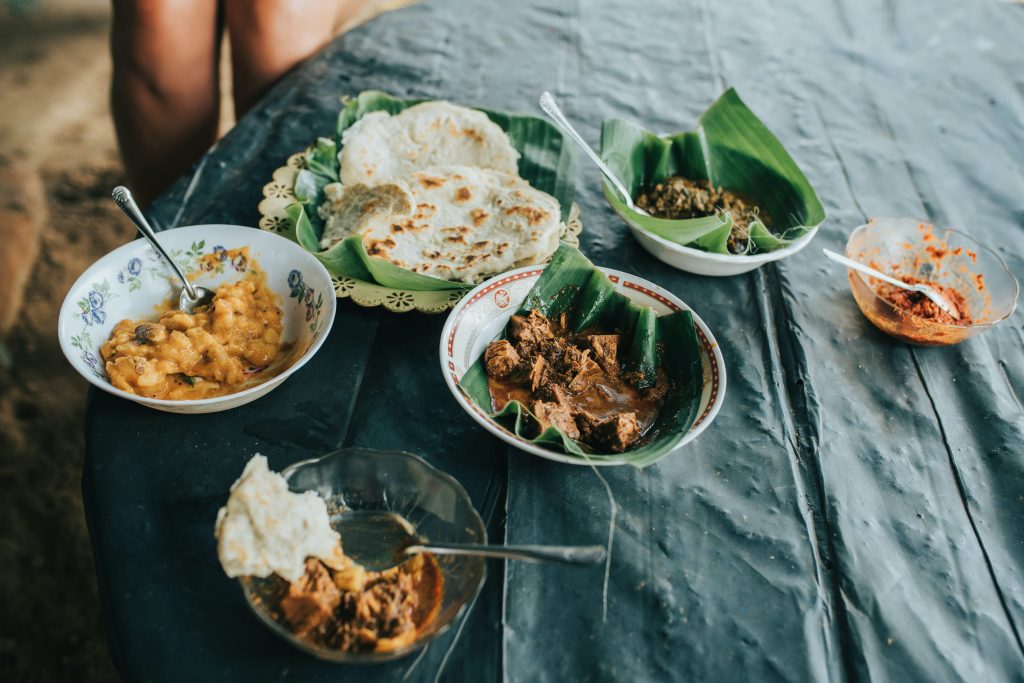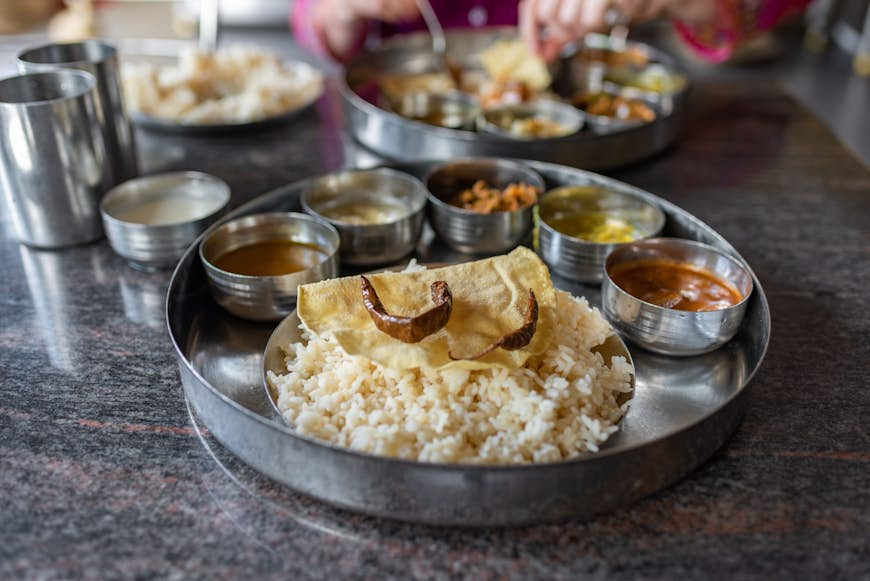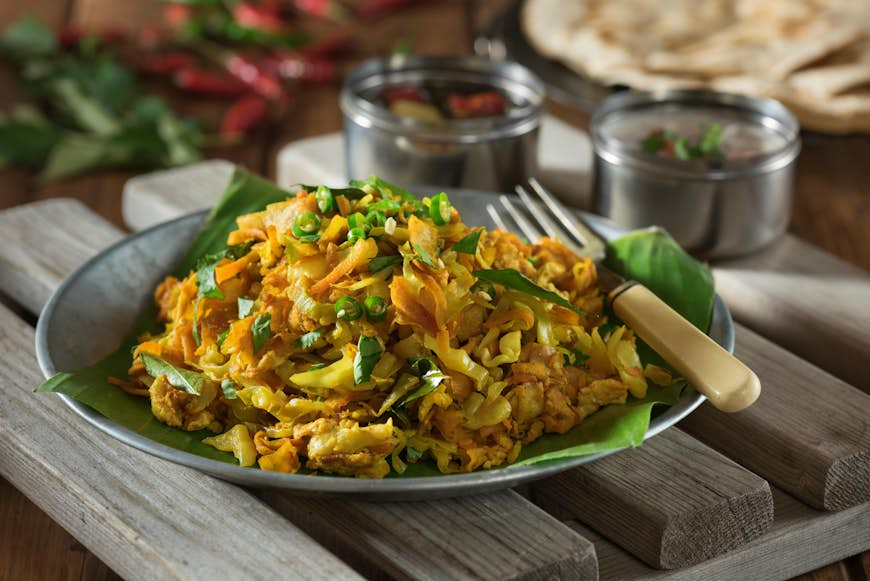
Amelting pot of Indian, Southeast Asian, and Arabic flavors as well as colonial influences, Sri Lankan cooking is a feast for the senses, drawing on incredibly fresh herbs and spices and the bounty of the land and sea.
Lonely Planet – September 16, 2022
Eating out in Sri Lanka is a delight, whether you tuck into authentic rice and curry at a roadside cafe, dive into a plate of kottu (chopped roti flatbread with vegetables and meat) at a downtown hole-in-the-wall or sample surf-fresh seafood at a swish oceanfront restaurant.
Munch on Sri Lankan hoppers
Made with a fermented batter of rice flour and coconut milk, hoppers – also known as appa or appam – are bowl-shaped pancakes with crispy edges and fluffy centers. Plain hoppers usually come with the chili and salt condiment lunu miris. Follow up with a savory egg hopper – chefs crack open an egg into a plain hopper and tip it off the skillet perfectly cooked. Hoppers also come with sweet milk or jaggery (palm sugar) and coconut milk, making quite the dessert.
Devour string hoppers with curry
Don’t let the name fool you – idi appa or idiyappam (string hoppers) are entirely different from ordinary hoppers. Often served for breakfast, these steamed rice flour noodles are hand-pressed into thin, delicate mats. No idi appa meal is complete without a side of pol sambol (grated coconut pounded with chili) and a creamy dal curry, cooked in thick coconut milk, scented and flavored with cinnamon and curry leaves.

Feast on rice and curry whenever you get the chance
This everyday staple is an umbrella term for a broad family of complex, intricately-spiced vegetable (and often meat and fish) dishes, served with rice – a bit like an Indian thali. A meal might consist of half a dozen curries, with at least one based on meat, poultry, fish, seafood or egg, and one made from dal (lentils). On the side, pickles, chutneys and pol sambol add extra heat. There’s also mallung, a leafy salad made with green leaves, chopped green chili, onions, and grated coconut.
Most Lankan curries are based on coconut milk, with a blend of spices – including but not limited to chili, turmeric, cinnamon, cardamom, coriander, lemongrass, rampe (pandanus leaves), curry leaves, mustard, and tamarind.
Amelting pot of Indian, Southeast Asian, and Arabic flavors as well as colonial influences, Sri Lankan cooking is a feast for the senses, drawing on incredibly fresh herbs and spices and the bounty of the land and sea.
Eating out in Sri Lanka is a delight, whether you tuck into authentic rice and curry at a roadside cafe, dive into a plate of kottu (chopped roti flatbread with vegetables and meat) at a downtown hole-in-the-wall or sample surf-fresh seafood at a swish oceanfront restaurant.
Munch down where the locals eat to enjoy Sri Lankan food at its most fiery and full-f

Sit down for a plate of kotthu
A spicy mishmash of leftover flatbread, fresh vegetables, egg and meat, kotthu is the island’s dinnertime favorite. This carb-heavy, popular hangover cure comes with a rhythmic soundtrack as the ingredients are chopped on a hot metal griddle with two metal blades.
This hard-to-miss metal-on-metal sound keeps the streets alive at night. Listen closely and you’ll notice that kotthu chefs all have their own, distinctive rhythm as they chop the ingredients. Chicken and pork kotthu are popular, but seafood versions with fish, crabs or prawns are easy to find in coastal regions.
Snack on isso vadai at Galle Face Green
Crispy, crunchy and slightly spicy, isso vadai is a fixture of Galle Face Green in Colombo, with a dozen or so vendors dotted around this open green in the city center. These deep-fried lentil-and-prawn fritters are the perfect snack to munch as you watch the sunset and listen to the hubbub of this bustling city. Here, it’s served with onion chutney unlike elsewhere in the country.

Start your day with pol roti
Toasted and sometimes slightly charred, pol roti is a Sri Lankan flatbread made with flour and grated coconut. This breakfast or dinner item often comes with a side of lunu miris (a condiment made from chili and salt) and a spice-laden chicken curry.
Note that pol roti is different from the flour-only ‘roti’ often served at tourist-oriented restaurants and beach shacks across the country; be sure to stop by a local family-run place for the real deal.

Tuck into Sri Lankan kiribath
Kiribath is the island’s celebratory dish, meaning people cook it on all special days (think New Year, weddings, the first day of a job or college). Made with traditional Sri Lankan kekulu rice cooked in thick coconut milk, kiribath is cooled down on banana leaves or a flat griddle, compressed and cut into diamond-shaped blocks before serving.
At home, locals often devour this specialty with a spoonful of lunu miris chili paste or katta sambol (a variation with onion and Maldive fish) – both are fiery, spicy accompaniments. Finish off any meal with a slice of kiribath with jaggery (palm sugar) or banana for the perfect sweet kick.


